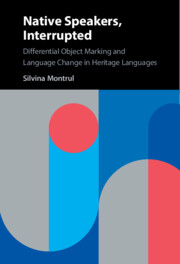Book contents
- Native Speakers, Interrupted
- Native Speakers, Interrupted
- Copyright page
- Dedication
- Contents
- Figures
- Tables
- Preface
- Abbreviations
- Introduction
- 1 On Heritage Speakers as Native Speakers
- 2 Structural Changes in Heritage Language Grammars
- 3 Differential Object Marking
- 4 Language Change and the Acquisition of Differential Object Marking
- 5 The Vulnerability of Differential Object Marking in Three Heritage Languages
- 6 Differential Object Marking in Spanish as a Heritage Language
- 7 Differential Object Marking in Hindi as a Heritage Language
- 8 Differential Object Marking and Clitic Doubling in Romanian as a Heritage Language
- 9 Comparing the Three Heritage Languages
- 10 Intergenerational Transmission
- Implications
- References
- Index
8 - Differential Object Marking and Clitic Doubling in Romanian as a Heritage Language
Published online by Cambridge University Press: 15 December 2022
- Native Speakers, Interrupted
- Native Speakers, Interrupted
- Copyright page
- Dedication
- Contents
- Figures
- Tables
- Preface
- Abbreviations
- Introduction
- 1 On Heritage Speakers as Native Speakers
- 2 Structural Changes in Heritage Language Grammars
- 3 Differential Object Marking
- 4 Language Change and the Acquisition of Differential Object Marking
- 5 The Vulnerability of Differential Object Marking in Three Heritage Languages
- 6 Differential Object Marking in Spanish as a Heritage Language
- 7 Differential Object Marking in Hindi as a Heritage Language
- 8 Differential Object Marking and Clitic Doubling in Romanian as a Heritage Language
- 9 Comparing the Three Heritage Languages
- 10 Intergenerational Transmission
- Implications
- References
- Index
Summary
Differential Object Marking (DOM) is vulnerable to change in heritage speakers of Spanish and heritage speakers of Hindi. DOM is also vulnerable to L1 attrition in Spanish-speaking first-generation immigrants but not in Hindi immigrants. This chapter examines DOM vulnerability in Romanian. The chapter describes the sociolinguistic characteristics of the Romanian-speaking population in the United, followed by a summary of the overall results of the linguistic background questionnaire and the linguistic tasks. The overall results show that, compared to the Spanish and Hindi-speaking populations, the Romanian-speaking population in the United States is far less numerous, yet their Romanian language skills remain relatively strong compared to the other two groups. The accuracy with DOM of the first-generation Romanian immigrants on all linguistic measures did not differ from those of the Romanian speakers in Romania. Just like in the Hindi study, there appears to be no evidence of language change in the homeland nor signs of attrition of this phenomenon in the first-generation adult immigrants sampled in this study. Yet, DOM and accusative clitic doubling (CD) were found to be somewhat vulnerable to omission in heritage speakers, especially in those exposed to English since birth or very early in life (the simultaneous bilinguals).
Keywords
- Type
- Chapter
- Information
- Native Speakers, InterruptedDifferential Object Marking and Language Change in Heritage Languages, pp. 205 - 226Publisher: Cambridge University PressPrint publication year: 2022



